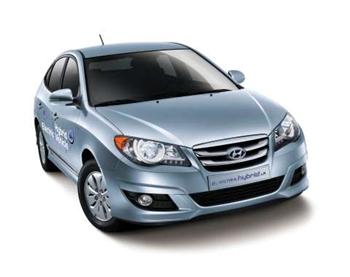|
Home | News | Road Tests | |||||||||||||||||||||||||||||||||||||||||||||||||||||||||||||||||||||||
Hyundai To Launch Elantra LPI Hybrid
Hyundai Motor Company, South Korea’s largest car maker, is about to release its Elantra LPI Hybrid Electric Vehicle (HEV) in South Korea. This model is the company's first hybrid vehicle for commercial sale. Hyundai will introduce the car in the South Korean domestic market on 8th July. The car, which is the world’s first hybrid electric vehicle to be powered by a Liquefied Petroleum Injected (LPI) engine, was first unveiled, in Korea, at the 2009 Seoul Motor Show in April. To be sold under the Avante badge in Korea, the LPI HEV will ensure eco-friendliness as well as economical operating costs and differentiated design. Powered by an LPI ‘Gamma’ engine displacing 1.6 litres, a 15 kW (105 Nm) electric motor and a Continuously Variable Transmission (CVT), the Elantra LPI HEV emits just 99 g/km of CO2 and 90 per cent fewer emissions than an equivalent standard 1.6 litre petrol powered Elantra to qualify as a Super Ultra Low Emission Vehicle (SULEV). Liquefied Petroleum Gas (LPG) is a low carbon emitting hydrocarbon fuel which burns more cleanly than petrol or diesel.
In addition, the Elantra LPI Hybrid is a mild–type hybrid+, with a fuel economy rating of 5.6 litres/100 km (or petrol equivalent of 4.5 litres/100 km). This represents a 47 per cent improvement over a conventional 1.6 litre Elantra with automatic transmission. It’s even cheaper to operate as the average price of LPG in Korea is 50% less than that of petrol. Hyundai Elantra LPI Hybrid is also the world’s first hybrid vehicle to adopt advanced Lithium Ion Polymer rechargeable batteries that have higher energy density, lower manufacturing costs, are more robust to physical damage and can also take more charge–discharge cycles before storage capacity begins to degrade than Lithium Ion Batteries. The technology and all key components in the Elantra LPI HEV have been developed by Hyundai and its local partners including the motor, battery and low DC/DC converter. Elantra LPI HEV Specifications
Note: + A mild-type hybrid is not capable of using the electric motor to propel the vehicle by itself. The electric motor works together with the engine to mobilise the car. A hard-type hybrid, or full-hybrid, provides assistance to the engine, but can also run in pure electric mode. Note *: Compared to the more prevalent Otto Cycle four-stroke combustion engine, the Atkinson Cycle has a power stroke which is longer than the compression stroke and is widely adopted by designers of Hybrid powertrains due to the increase in fuel economy it provides. Internal combustion engines can be divided into several categories according to the combustion principles: Otto cycle, Miller cycle, Lenoir cycle, Atkinson cycle, Brayton/Joule cycle, diesel cycle and Homogeneous Charge Compression Ignition. | |||||||||||||||||||||||||||||||||||||||||||||||||||||||||||||||||||||||
More Hyundai News .....
here
About | Car Clubs | Home | News | Road Ramblings | Road Tests | Subscribe | Top Drive © 2009 All rights reserved. Next Car Pty. Ltd. |




